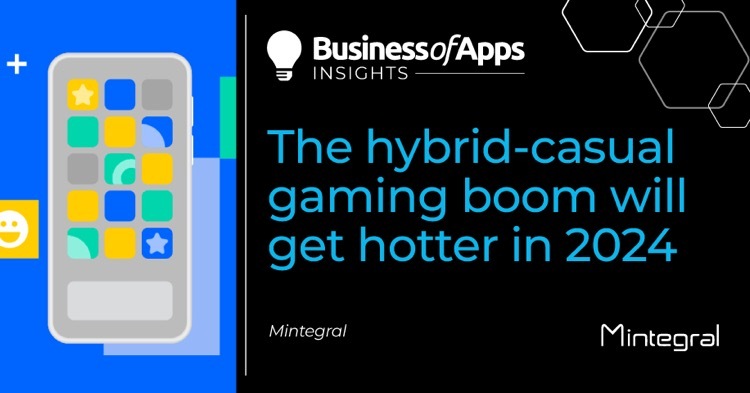In the evolving mobile gaming landscape, the hottest trend is hybrid-casual games, where downloads grew by 13% and revenues reached $1.4 billion in 2022.
Hybrid-casual fills a need between hyper-casual games, usually free-to-play games with simple gaming mechanisms, and mid-core games, which customers purchase to play and are rewarded with intricate gameplay and impressive upgrades achieved through leveling up. This category has captured gamers’ attention, where time spent surged by 80% between 2019 and 2021.
Its blend of hyper-casual’s straightforward mechanics and mid-core’s intricate monetization and features defines it. Hybrid-casual addresses the competitive challenges of the hyper-casual genre by ensuring deeper engagement and retention. This approach combines intuitive gameplay with layered elements such as progression events, leaderboards, collectibles, and harmonized monetization of both in-app purchases and ads.
At Mintegral, we have traditionally served as a strong ally to game developers, witnessing significant shifts in the gaming landscape over the past six months. The hyper-casual gaming sphere, in particular, has undergone a noteworthy transformation in its monetization strategies. Notably, many hyper-casual developers are looking at the benefits of a hybrid-casual approach to diversify revenue streams. This evolution involves the incorporation of more mid-core gaming elements, including the integration of in-app purchases.
During our recent earnings call, Mobvista’s CEO, Clement Cao, emphasized a pivotal observation shaping the trajectory of hyper-casual gaming. Leading entities in the hyper-casual gaming sector are beginning to diversify from sole in-app advertising (IAA) products to embrace hybrid monetization strategies, which combine IAA with in-app purchases (IAP), defining a new category known as hybrid-casual gaming. This shift prompts hyper-casual game advertisers to reallocate budgets into alternative verticals, such as mid-core games.
Hybrid-casual games have emerged as a compelling solution, offering engaging and straightforward gameplay while unlocking enhanced revenue potential.
Captivating players with their unique blend of genres and gameplay experiences, hybrid-casual games present an exciting opportunity.
While hybrid-casual games suggest potential in combining elements from different game types, it’s essential to recognize that many players, especially those new to gaming, aren’t necessarily clamoring for significantly increased sophistication in their gameplay. Instead, the gaming industry’s evolving landscape might be driving these trends.
Many game companies are embracing hybrid-casual games as a key component of a diversification strategy, which we are seeing across multiple major players. Zynga’s acquisition of the A Bit Lucky studio and Voodoo’s transition to more hybrid-casual releases clearly indicate that a broad game roster can help organizations serve customers of all interests.
Here are the industry trends driving the hyper-casual market
Expanding potential audiences
While hyper-casual games still widely appeal to their original audiences, adding more complexity or customization enables those same developers to pull in some mid-core audiences that found hyper-casual games too simple or the reward structure too limiting. The more potential customers an app has, the broader the audience targeting it can utilize, driving down per-acquisition costs if targeting is done efficiently.
Increased interest in customization
Hybrid-casual games with features like collection systems and rich narratives deepen player engagement, while customization avenues cater to player individuality and open up monetization routes. They allow players to express their creativity and individuality by customizing characters, which produces additional advertising and monetization opportunities. The usage rate of collectible albums has increased from 20% to 70%. For example, the hybrid-casual game AFK Arena offers one free customization pack, but interested gamers can purchase additional packs at various price points.
Cross-promotion from hyper-casual games
The ability to cross-promote from hyper-casual titles to these higher-monetizing hybrid-casual games offers developers an edge, allowing them to navigate industry headwinds with a flexible, dynamic strategy. Cross-promotion for hybrid-casual devs and porting them over into more ‘involved’ games where they can more easily monetize through longer player lifetimes.
While the future is still bright for hyper-casual games, the hybrid-casual movement is mobile gaming’s next big thing. Developers of all types of games would benefit from investing in this category as they encounter significant market headwinds to reduce user acquisition costs, increase retention, and grow their potential audiences. The name of the game for any developer, as always, is diversification.











